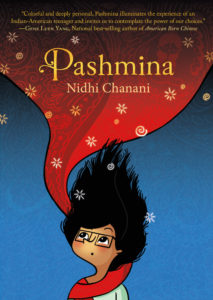Fleen Book Corner: Pashmina
A few obligatories as we get started. One, I spent some time during NYCC having a really nice dinner and conversation with Nidhi Chanani; the book didn’t come up apart from Hooray! It’s out! I need to pick up a copy! Two, there will be spoilers ahead.
I’ve been waiting for Nidhi Chanani’s debut graphic novel, Pashmina, since it was first mentioned on the upcoming season lists from :01 Books about a year ago. Since then, I’ve been lucky enough to become friends with Chanani, and I’ve been even more interested in seeing what she’d come up with when given the opportunity to tell a story.
She’s better known as a illustrator, but it’s clear she’s got stories in her — case in point, check out these two. There’s a moment presented, but you know that Chanani knows what brought those two to this point in time, and where they’re going from here. I suspect that frozen moments from stories similar to Pashmina have been snapshotted in her illustrations, and now we get to see the instants that lead up to them and the ones that come after.
Priyanka (or Pri, when she’s trying to downplay her sense of being different) is a typical SoCal teen, or at least she wants to be; she has to navigate the usual terrible high school experiences¹ and lack of confidence (Pri draws comics enough to have a favorite pen, whose absence will provoke minor panic — one of many touches I suspect are autobiographical²) that come with the age. Most keenly, she feels only half served by her Indian heritage (specifically that of Kolkata, which is in Bengal, in the northeastern corner of India), what with her single mother being unwilling to talk about India, her father, or what brought her to America in the first place.
She knows Indian food is great, and having aunties and uncles that love her is a perk, but believing in intercessionary gods is a bit much to ask when she doesn’t have a sense of India. Mom tells her India is poor and dirty and unimportant and she’s never going back, and that’s all there is to it; this provokes all the hellbent curiosity of any teen that’s told It’s not important for you to know that.
That’s when she finds the magic pashmina in her mother’s luggage, the one that transports her to India, of a sort. It’s all fabulous architecture, warm waters, amazing food, beautiful vistas, and she has animal sidekicks that are very certain that everything is brightly perfect. It’s the Disney version (although closer to Epcot than It’s A Small World) where any unpleasantness is carefully excised and tucked away out of sight … except for that one shadow that seems to follow her around. Pay no attention to, it’s not important, everything is great here her animal sidekicks insist in a perfect inversion of her mother’s dismissal of anything positive about India.
When the time comes to visit the aunt and uncle she’s never met, Pri finds in short order that her sidekicks are right, and her mother is right, and there’s a patriarchal overcast on the entire society that’s leaving her confused. Worse, the pashmina doesn’t work for her anymore. She wanted to be in India and she’s there and so the candy-colored version isn’t necessary, but the mystery of where the pashmina came from and how it got its power becomes a priority.
It’s at this point, three quarters of the way through, that the story really starts to come together. Pri’s journey isn’t just about learning her personal history, it’s about learning the sweep of the history and society she comes from — why her mother fled India, how girls are undervalued and exploited, the possibility of making things better.
She gets the information she sought, but she finds that wisdom and happy endings don’t necessarily go hand in hand. The veil that falls from her eyes looses her voice, though — the pashmina shows possibilities, and Pri (or Priyanka, as she’s starting to prefer) can tell stories that tell of choices. Even the intercessionary gods that you don’t really believe in need storytellers.
If there’s a place for improvement in Pashmina, it’s that the last quarter of the book runs at a much faster pace than all that came before it. The earlier portions of the story felt organic and lived-in, and the tail end seemed abrupt by comparison. It would have benefited from Pri being able to slow down and take in all the strangeness at the same pace she took in smaller challenges in familiar surroundings.
Then again, when the worst I can say of a book is that I wish it had another three dozen pages to spend on its protagonist, you’re doing pretty damn well, and debut stories aren’t given the resources of proven creators. I expect that Chanani’s next book will reflect an increase in confidence from the market and the pages that will come with it. After all, her art features a lot of characters waiting to share their stories, and her readers have a world of choices to be shown.
Spam of the day:
Regal Comfort 6 Piece Sheet Set
Wow, a choice of colors and sizes? Where else could I possible get that? Oh yeah, everywhere.
_______________
¹ The mean, pretty, blonde girl at least only craps on Pri because she considers her poor, not for being brown.
² Pri was born just after her mom came to America, Chanani just before her family emigrated; they’re similar enough in their experiences except Chanani’s old enough not to have had an iPod as a teen.

The above comments are owned by whoever posted them. The staff of Fleen are not responsible for them in any way.